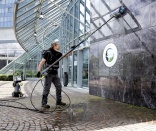Home › magazine › product features › What’s all the pressure for?
What’s all the pressure for?
23rd of January 2024What are the main functions of high-pressure machines these days? Are new applications emerging all the time in line with green energy developments and innovative building designs? And are there certain tasks that can only be tackled with the aid of a high-pressure cleaner? Ann Laffeaty poses these questions to industry manufacturers.
HIGH-PRESSURE CLEANING machines are an extraordinary phenomenon – and a long-lived one, at that. Since their inception around 100 years ago they have become the go-to solution for any problematical cleaning task that cannot be successfully carried out using other machines or solutions. And their scope is broadening all the time.
So it is odd to discover that the technology behind high-pressure cleaners first emerged as the result of a mistake.
It happened during the prohibition era in the US when a man called Frank W Ofeldt II was working on a whisky still for a local moonshiner. The year was 1926 and the location was a Pennsylvanian town on the banks of the Ohio. While operating the still, Ofeldt suddenly became aware of the fact that his usually grimy garage floor had suddenly become very clean. And he quickly realised this was as a result of steam from the still which was being forced at high pressure through a small hose. This steam was effectively removing the grease from his floor and leaving it cleaner than he had ever seen it.
Since Ofeldt came from a family of engineering pioneers he recognised the fact that steam alone - being a wholly gasified liquid lacking in mass or body - could only relocate the grease and was unable to actually remove it. But he realised the potential of his discovery and began an immediate personal crusade to create a contraption that could mix wet steam with chemical agents.
This led to the production of the High Pressure Jenny which was equipped with a positive displacement triplex pump with an oil-bath crank-case. Fast-forward around 25 years and manufacturer Kärcher had now entered the market. Kärcher was responsible for creating the first real commercial pressure washer - the DS30 - in 1950 and this led on to numerous upgrades and innovations both by Kärcher and by various other rival companies that had begun to spring up.
Many uses
These early models were used for decontamination and cleaning applications in the military and in other industries. During the 1950s and 1960s Kärcher continued to develop and expand its design and the company’s Cat Pump revolutionised the inner workings of the device. And by the mid 1970s, piston pumps had emerged, giving rise to the modern pressure washers we have today.
High-pressure cleaning equipment is now used for a whole host of applications including forecourt cleaning, vehicle cleaning, the removal of paint and grime from walls and for restoring building façades.
But how is the use of these machines evolving as new technologies and building designs emerge? And what are the latest applications to which they are being put?
Vehicle-cleaning remains one of the chief uses of high-pressure cleaners today according to high-pressure cleaner product manager for Kärcher Volker Steigauf. “Vehicles such as trucks, construction machines and farm equipment all tend to be cleaned using high pressure,” he said.
“Other applications include the cleaning of buildings façades as well as the floors and walls inside the premises, and for pressure-washing swimming pools and changing rooms. And the technology is also used for cleaning large outdoor areas in municipalities.”
However, customer demand is changing, according to Steigauf. “There is an increasing move towards using high-pressure equipment for tasks such as cleaning large areas of solar panels, the heat exchangers on air-conditioning units and for cleaning heat pumps,” he said.
But while new applications are emerging, customers are largely still using the same cleaning methods as they did in the past, he adds. “They are mainly sticking to the same methodology but are using different accessories for their high-pressure cleaners depending on the task in hand,” he said. “For example there are now specific rotating brushes that have been designed for cleaning solar panels, while for graffiti removal there are new bespoke detergents that may be used in conjunction with high-pressure cleaners.
“And for façade cleaning there are various types of accessories on the market ranging from rotating roller heads and brushes to multi-purpose telescopic lances, adapter sets and ergonomic carrier systems.”
Kärcher offers a complete range of cold and hot water high-pressure cleaners including the iSolar Cleaning solution designed for use on solar and photovoltaic systems. Equipped with rotating brushes attached to a telescopic lance, the machine is said to be able to economically clean areas of up to 1,500 square metres. Accessories available with machines include surface cleaners, foam-systems and façade cleaning systems.
Deep and effective cleaning
Today’s high-pressure washers are commonly used for cleaning building façades, vehicles, driveways and other outdoor areas says Chiara Molardi, marketing specialist at IPC by Tennant Company. “Their ability to remove substances such as dirt, grime and stains using the power of water at high pressure makes them ideal for operations that require deep and effective cleaning,” she said.
However, she agrees with Steigauf that the use of high-pressure cleaners has been evolving over recent years.
“While traditional applications such as the cleaning of building façades, vehicles and outdoor areas remain prevalent, newer applications have emerged such as graffiti removal and green space maintenance,” she said. “This is because high-pressure cleaning is an efficient method of removing graffiti and can also be employed for weed removal and for public area maintenance.”
The new IPC Green Jet hot water machine has been specifically designed for weed removal. Described as being eco-friendly, it removes weeds using hot water alone and is said to be particularly suitable for use in municipalities, agriculture and in any public area where the use of pesticides is frowned upon.
Today’s high-pressure cleaners are used for cleaning up after fire and flood damage as well as for other, more typical building and vehicle cleaning applications, says DiBO’s communications manager Kat Coppieters.
“They can also be used for removing old concrete and levelling surfaces in renovation projects,” she said. “And they have found other uses in the construction, agricultural, shipbuilding, transport and food production sectors as well.”
While their key applications have remained constant, she agrees with other commentators that newer applications are emerging. “Since Covid there has been a greater focus on hygienic cleaning and on steam cleaning in particular,” says Coppieters. “Other newer applications include graffiti removal, solar panel cleaning and gum removal. And high-pressure machines can also be used for controlling weeds and moss in the grounds of schools, hospitals, crèches and care establishments where pesticides might be prohibited.”
Detaches soiling
DiBO offers weed-killing machines that are said to keep the heat to a consistent temperature of 99 degrees centigrade – which Coppieters claims to be the best temperature for killing weeds.
She claims steam cleaning also works well for many applications since it easily detaches soiling from surfaces while also deactivating pathogens, bacteria and viruses.
“The steam penetrates the cracks, joints and any irregularities in the surface that can be particularly hard to reach with a cloth or brush,” she says. Other relatively recent uses of the technology include the cleaning of bus shelters, traffic signs, bicycle shelters and bins plus the removal of posters and glue residues.
So, are there any cleaning tasks that only a high-pressure cleaner can tackle? And what does the future hold for the sector?
IPC’s Chiara Molardi believes these machines are irreplaceable for certain applications. “High-pressure equipment is necessary for removing tough stains from concrete surfaces; for degreasing industrial machinery and for effectively removing graffiti because their power and precision make them indispensable for such demanding cleaning tasks,” she said.
According to Kärcher’s Volker Steigauf, only a high-pressure cleaner can cope with cleaning complex structures such as undercuts, crevices and gaps on machinery or facades. “They are also able to tackle these jobs quickly and inexpensively,” he says. “And looking to the future, I think we are going to see an increasing demand for cleaning heat exchangers in order to maintain efficiency at a high level.”









